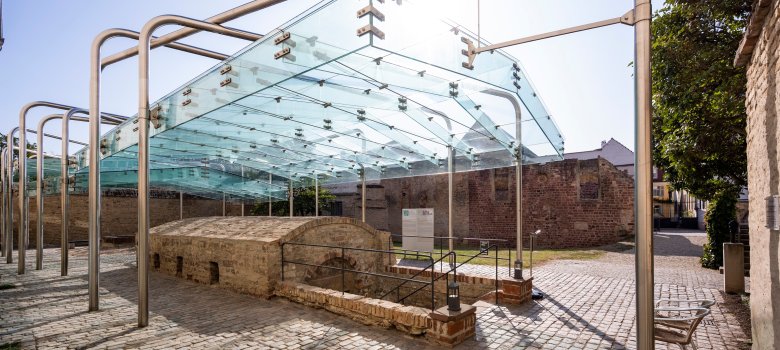
The SchUM Sites
The Jewish communities in the cities of Speyer, Worms and Mainz formed a covenant during the Middle Ages that became known under the name of “SchUM”. The term is put together from the first Hebrew letters of the three cities. These SchUM sites reflect hundreds of long years of tradition for Ashkenazic Judaism. During the Middle Ages, SchUM was influential not only in architectural respects but in religious respects as well. The monuments have been preserved until today and are for the most part accessible to interested parties. As of July 2021, the SchUM sites have been officially incorporated into the UNESCO World Heritage Site list.
Jewish Courtyard
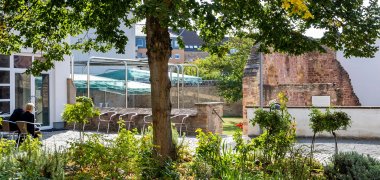 © Klaus VenusThe Jewish Courtyard.
© Klaus VenusThe Jewish Courtyard.The Jewish courtyard can be found in close proximity to the Cathedral. At one time, it was the focal point of the second Jewish settlement in Speyer and the location of religious and intellectual exchanges. Scholars who lived in the SchUM cities were known well beyond its borders. In the 12th Century, Speyer attained a particular reputation as a place to study. A group of intellectuals even became known in history as the Wise Men of Speyer.
Today you can find in the Jewish Courtyard the remnants of the medieval synagogue consecrated in 1104. Next to it are the remains of a women’s synagogue as well as a ritual bath. The Schpira Museum has been set up in a nearby house.
The SchPIRA Museum
The didactically well equipped museum provides a glimpse into the cultural and ritual life of Speyer’s Jews (as represented by synagogue, ritual bath and cemetery) with the help of its archeological exhibits and textual descriptions.
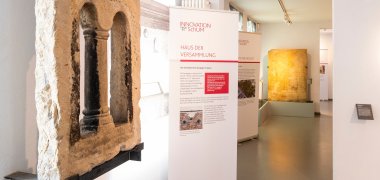 © Klaus VenusArched window in the museum.
© Klaus VenusArched window in the museum.While remains of the synagogue and Mikvah have been preserved and can be viewed in their original form, the cemetery and homes no longer exist. The medieval buildings of the “Alten Judengasse” (today renamed “Kleine Pfaffengasse”) were destroyed in the big city fire of 1689; a new housing development arose in their place during the 18th century.
In order to set up the SchPIRA Museum, the Historical Museum of the Palatinate and the State Office for Historic Preservation have made long-term loans of their Judaica collections available. Among the items to be seen are arched windows and capitals as well as gravestones, coins and floor tiles.
Currently, additional exhibits are being developed by the SchPIRA Museum. Next to a new media space in which films will be presented on the Mikvah and the Jewish Cemetery in multiple languages, an interactive media station has been installed as a small additional attraction.
Medieval Synagogue with Women’s Synagogue (School)
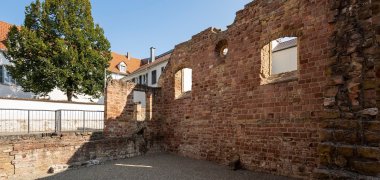 © Klaus VenusEastern walls of the middel-aged Synagogue.
© Klaus VenusEastern walls of the middel-aged Synagogue.In the 10th and 11th centuries, Jews and Jewesses settled along the Rhine for the first time since antiquity and in doing so, started a thousand-year history of synagogue construction in Germany. Speyer’s synagogue, consecrated in 1104, was a Romanesque hall with a width of a a little over 35 feet and a length of just over 57 feet. The remains of the synagogue as seen today make it the oldest existing Jewish ritual structure from the Middle Ages. Various structural components at Jewish cultural sites are to be found in similar form at Speyer Cathedral and suggest the participation of the craftsmen from the Cathedral in their construction. For the Jews and Jewesses in the settlement, their trade activities were essential, making them poorly suited to construction work. They were able to function as craftspersons only in exceptional cases.
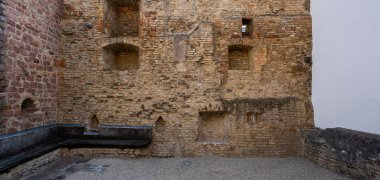 © Klaus VenusWomen´s Synagogue with bench.
© Klaus VenusWomen´s Synagogue with bench.We know little about the interior furnishings of the synagogue. From a note in the rabbinical literature we learn that it had glazed Windows and a floor covered with stone slabs. Traces of the window framing are visible on the two windows on the west wall.
In addition to the men’s synagogues in Germany, there were also similar ones for women called Women’s Schools. In the SchUM cities, it was customary, beginning in the 13th century, to build such spaces adjoining the original synagogue. These were partially, as in Worms and Speyer, connected to the men’s synagogue by means of sound outlets so that the women were able to participate in the goings-on. The existence of the Women’s School allows the assumption that women within the Jewish community were more highly regarded than is generally assumed. Apart from the ornamentally decorated floor tiles, the furnishings were rather unpretentious and limited to a single bench for seating that ran completely around the room.This Jewish house of worship was defiled during the pogrom of 1349 and placed back into operation in 1354 with some structural alterations. After the expulsion of the Jews and Jewesses in the early 16th century, it was finally demolished and the floor covered with coarse pavement in connection with its reconstruction as a municipal armory.
Ritual Bath/ Mikvah
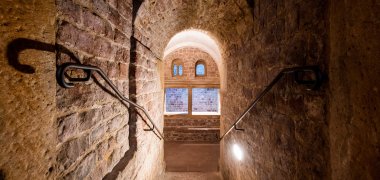 © Klaus VenusStairs to the lower level of the ritual bath.
© Klaus VenusStairs to the lower level of the ritual bath.The Community built the ritual bath, the so-called Mikvah at very nearly the same time as the synagogue. It is located not far from the synagogue and is the oldest installation of its kind north of the Alps.
The Mikvah provided ritual cleansing. It was used primarily by women after giving birth and after menstruation as well as before marriage. Occasionally, men also used it.
A barrel-vaulted stairway leads via a vestibule to a square bathing pit with groined vault set at a depth of 33 feet. Here the faithful encountered naturally flowing water which was considered to be “living” water consistent with the ritual cleansing by immersion prescribed by Mosaic laws. Steps lead down to the actual bathing pit, the water level of which rose and fell with the groundwater. Quicksand on the floor saw to it that the water was constantly recycled. Although the water was very cold, the gentle current kept the water from freezing during the cold winter months.
The Mikvah is decorated with opulent Romanesque ornamentation that was colored during the Middle Ages. A two-part windowed area provides a view into the bathing pit. The installation is protected these days by a glass structure.The Yeshiva
No longer visible today but retained in its foundations and hidden in the ground is the Yeshiva. Yeshivas are schools of higher learning which are dedicated to the study of the Talmud and the Torah.
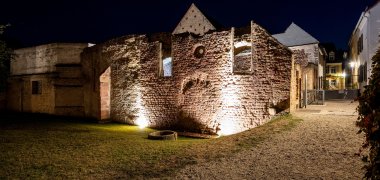 © Klaus VenusRemains of the Yeshiva.
© Klaus VenusRemains of the Yeshiva.In Speyer during the first half of the 14th Century, this educational institution stood as an annex along the east wall of the synagogue’s courtyard. It shows the esteem in which religious teaching and learning were held in Judaism. Its original shape is still suggested today by the circumferential wall around the yard area and the east wall of the synagogue.
I
The Jewish Cemetery — the Eternal House
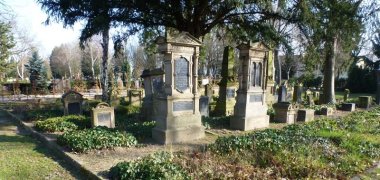 © Stadt SpeyerThe cemetery of the Jewish community of Speyer dates back to 1888. The picture shows the north-eastern burial ground.
© Stadt SpeyerThe cemetery of the Jewish community of Speyer dates back to 1888. The picture shows the north-eastern burial ground.The cemetery has a central role in a Jewish community — without one, a settlement can not qualify as a Jewish community. As early as 1084, Bishop Rüdiger awarded the Jews a plot near today’s railroad station as their cemetery.
Compared to the Christian tradition according to which graves can be leveled after expiration of a certain resting period, Jewish burial places were and are considered eternal. However, with the disappearance of the Jewish community in the 15th century, the original cemetery was closed and some of the gravestones were reused as building material. Some of them were later rediscovered and can be seen today in the SchPIRA Museum.
Came the 19th century and Jews and Jewesses slowly returned to Speyer. Since 1888, the Israelite community of Speyer has interred their dead at the Jewish Cemetery on the Wormser Landstrasse.
Jewish Life Today
During the 18th century, the Jewish population increased steadily. Until the seizure of power by the National Socialists, Speyer had once again become a center of Jewish culture. With the destruction of the synagogue on Crystal Night, the life of the Jewish community came to a sudden end. Today, a memorial as well as sidewalk bricks serve as reminders of their fate. It was not until the 1990s that Jews and Jewesses once again immigrated back into the city. Today, Speyer is one of the locations of the Jewish religious community in the Rhineland-Palatinate.
Beth Shalom Synagogue
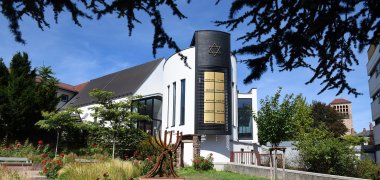 © Klaus LandryThe new Synagogue Beith-Shalom.
© Klaus LandryThe new Synagogue Beith-Shalom.The Jewish community is once again a visible part of life in Speyer. Exactly 73 years after the destruction of their old house of worship by the National Socialists, the tradition-rich SchUM city of Speyer has a new synagogue: Beth Shalom — House of Peace.
The 3-story synagogue building emerged not far from the site of the first settlement of Jews and Jewesses in Speyer. To accomplish it, the Cloister Church of St. Guido, which was no longer being used, was refurbished. First the original building was cut back in order to make it possible to place the new sacred building in the form of an ellipse diagonally along the eastern foundation. However, a new base had to be created beforehand because the previous structure was defined by a rectangular altar space built over a cellar.
Like the two other SchUM cities, Mainz and Worms, Speyer holds an extraordinarily meaningful place in the history of Judaism. With the new synagogue, which also serves as a community center, Jewish life has once more become a visible part of life in Speyer.
Memorial for the Jewish victims of the Nazi persecutions of 1933-1945
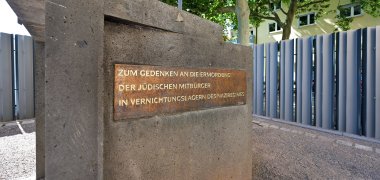 © Klaus LandryMemorial with commemorative inscription.
© Klaus LandryMemorial with commemorative inscription.At the corner of Heller- and Karlsgasse stands the memorial “In Remembrance of the Jewish Victims of Nazi Persecution”. It was crafted out of basalt lava by the Speyer artist, Wolf Spitzer and contains inside a piece of the floor of the synagogue that was destroyed during the pogrom sponsored by the Third Reich.
The memorial itself has a vibrant history and has “grown” over the years into its present form. It started in 1978 as a commemorative plaque on the western facade of the Kaufhof department store. During a memorial service 10 years later, the idea of erecting a more suitable memorial emerged. On 9 November 1992, the basalt lava cube fashioned by Spitzer was revealed in front of the memorial plaque. Several years later, it was transferred to a more suitable location. In addition, the bronze plaque was supplemented with the names of the victims and a woven iron canopy was added as well. The completed memorial was finally presented to the public in July 2020. It represents the memory of a horror but it also stands for hope, love and tolerance,
A detailed brochure on the memorial is available at the Tourist Information, Maximilianstraße 13, at the price of 3 euros.
Paving Bricks
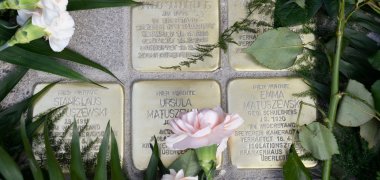 © Klaus VenusStolpersteine in the street Im Lenhart 35 in memory of Jakob und Emma Schultheis sowie Emma, Stanislaus und Ursula Matuszewski
© Klaus VenusStolpersteine in the street Im Lenhart 35 in memory of Jakob und Emma Schultheis sowie Emma, Stanislaus und Ursula MatuszewskiThe paving bricks are the project of the artist, Gunter Demnig. He reminds us about the persons who during the NS era were tracked, deported, expelled, driven to commit suicide or murdered. The paving bricks are set into the sidewalk in front of the last known self-chosen residence of each pursued person. Each brick bears only one name, one human being. With more than 70,000 bricks placed thus far in 1,265 communities in Germany and 21 other European countries, these paving bricks form the largest decentralized memorial in the world.
The initiative, “Paving Stones for Speyer” seeks to maintain the memory of those citizens of Speyer who were persecuted by the NS-regime. Their names and fates are to be brought visibly back into the city’s memory.
In so doing, it is important to the initiators that the memory of all who were pursued by the National Socialists — not just the fellow citizens of the Jewish persuasion but also the resistance fighters, those stigmatized as “antisocial”, homosexual citizens, victims of euthanasia, politically persecuted citizens and all other victims — be included.

